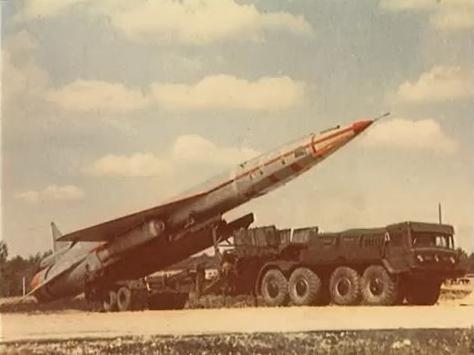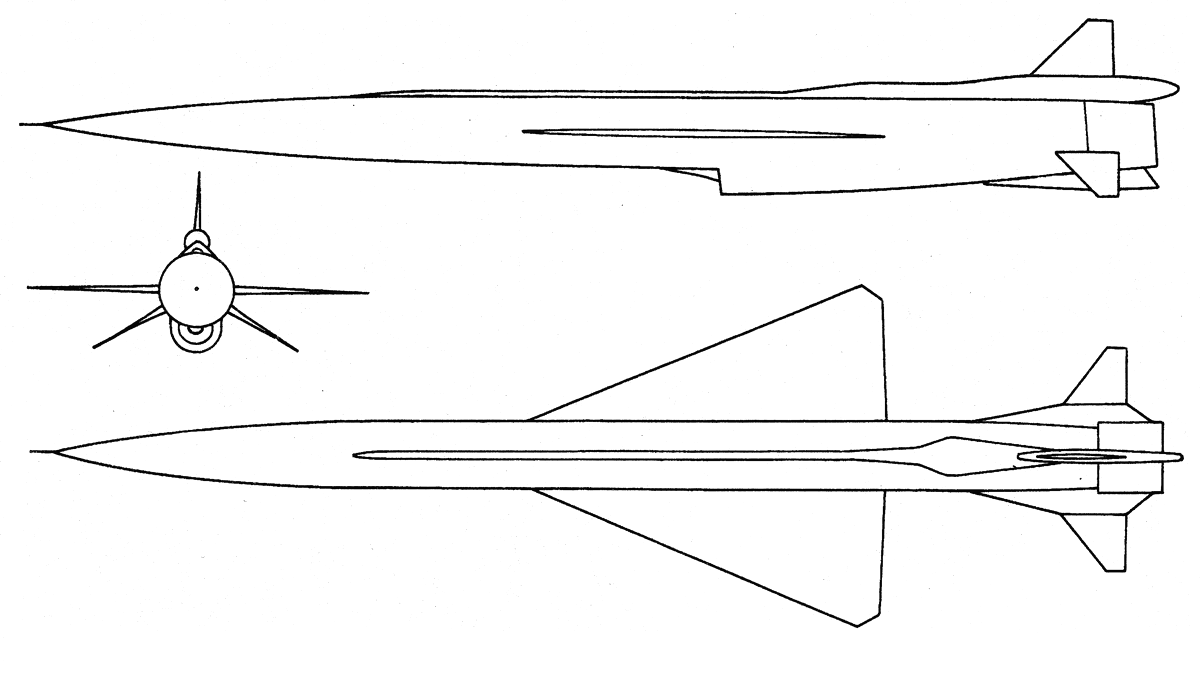The Tu-123 «Yastreb» (another designation: DBR-1) – supersonic unmanned aerial vehicle (UAV), created by the Tupolev Design Bureau (Tupolev OKB-156) at the early 1960s in the Soviet Union. It was intended to conduct the photographic and electronic reconnaissance at ranges up to 3,200 km.[1-4]
The DBR-1 was created on base of the Tu-121 UAV (was in developing since 1957, but the project was canceled in 1960) – supersonic long-range unmanned flying bomb (without necessity at takeoff from aerodrome) intended for destruction of targets by nuclear warheads at ranges of up to 4,000 km. Factory test DBR-1 was completed in September of 1961, and the state test – in December of 1963. In May of 1964 DBR-1 «Yastreb» was adopted by the Soviet Army Air Force, becoming the first-born in a family of unmanned reconnaissance systems of the Tupolev Design Bureau.[1-4][12]
The DBR-1 system consisted of the SARD-1 (STA-30) launch vehicle on base of the MAZ-537 lorry (for carrying missiles) with the SURD-1 (ST-30) semi-trailer – starting installation, the KARD-1S (KSM-123) control-starting vehicle and the UAV itself.[2]
The Tu-123 UAV was an all-metal monoplane with a delta wing and trapezoidal empennage. The wing had no means of mechanization and control, all control of the UAV in flight was carried by all-moving keel and stabilizer: a stabilizer deflected synchronously for pitch control, and differential – for roll control. The control surfaces deviated by means of hydraulic actuators that are cooled by spirits-water mixture in flight.[2]
The fuselage of the Tu-123 UAV was structurally composed of six sections. All reconnaissance and part of navigation and piloting equipment were mounted in the F-1 nasal module. The F-2, F-3 and F-4 modules are the welded integral fuel tanks for the fuel system with capacity of 19,000 liters. The turbojet engine, the units of electrical equipment, the navigation and landing complex, the steering actuator, the brake parachute, the cooling system were installed in the F-5 and F-6 rear modules. The F-1 module was the saved instrumental reusable container, while the rest of the UAV (F-2 – F-6 sections) was the one-off.[2]
The AFA-41/20M perspective aerial camera, the three AFA-54/100M plane aerial cameras, the SU3-RE photoelectric light meter, the SRS-6RD “Romb-4A” electronic reconnaissance station, the Doppler navigation station, the radio transponder, the radio beacon, the autonomous power supply system, the air conditioning and pressurization system, the parachute landing system, the four-post chassis with pneumatic drive were placed in the nasal container of the Tu-123 UAV.[2]
The control system of the Tu-123 UAV is the navigation and piloting complex programmable before flight. The UAV was directed by the homing radio station of complex at the final (returning) stage of flight.[2]
The Tu-123 UAV was launched from the boom of the ST-30 installation at an angle of 12 degrees to the horizontal. The PRD-52 boosters were separated on the fifth second and the subsonic air intake manifold was shot back on the ninth second of flight. The UAV reached the march 19 km altitude, which was 22.8 km after running out of fuel at the end of the route. The flight and work of the photo devices passed according to the previously mortgaged program. The on-board homing equipment automatically was switched on after turning back and arrival to the landing place at a distance of 400-500 km.[2]
The ground radar was switched to the auto-tracking mode and the homing system was switched on after interception and identification of UAV, providing instructions to the drone about radio guidance and landing of the instrument module at a given point. Further, the engine was stopped, the remaining fuel poured out from tanks, the speed was decreased, the braking parachute was led out above engine’s nozzle and the UAV began to decline. Then, the instrumental nasal module of UAV was shot back and the landing parachute of module was used. The four landing legs of chassis were led out for amortization, the automatic radio beacon was switched on after landing (for facilitating the instrumental module’s search by ground crew).[2]
| Specifications of the Tu-123 UAV: [1-4] | ||
| Length, m | 27.84 | |
| Wingspan, m | 8.41 | |
| Height, m | 4.78 | |
| Empty weight, kg | 11,450 | |
| Take-off weight with boosters, kg | 35,610 | |
| Engine | 1 x Turbojet R-15K-300 | |
| Traction of engine (afterburner), kgf | 10,000 | |
| Resource, h | 50 | |
| Traction of PRD-52 boosters, kgf | 2 x 75,000-80,000 | |
| Work time of PRD-52 boosters, s | 5 | |
| Cruising speed, km/h (M=) | 2,700 (2.5) | |
| Altitude, m | 19,000-22,800 | |
| Technical range, km | 3,560-3,680 | |
| Flight range, km | 3,200 |
Mass production of the Tu-123 «Yastreb» was carried out in Voronezh (now – the Russian Federation), at the plant N 64, from 1964 to 1972. A total of 52 units were manufactured. The reconnaissance units of Air Force, which were stationed in the western military districts of the Soviet Union, were armed by this system until 1979. The launches of the UAV during the exercise have repeatedly confirmed the high reliability and the stated performance characteristics. The DBR-1 complexes gradually began to remove from service after adopting a MiG-25R reconnaissance aircraft.[2]
References:
1. Tupolev Tu-123. – Mode of access: http://en.wikipedia.org/wiki/Tupolev_Tu-123.
2. Ту-123. – Mode of access: http://ru.wikipedia.org/wiki/%D0%94%D0%91%D0%A0-1.
3. “123 Ястреб” Туполева. – Mode of access: http://www.testpilot.ru/russia/tupolev/123/123.htm.
4. Туполев Ту-123 Ястреб. – Mode of access: http://www.airwar.ru/enc/spy/tu123.html.
5. Бесконтактная война. – Mode of access: http://www.youtube.com/watch?v=pbuEqH-Rxpc.
6. Беспилотник-“Ястреб”. – Mode of access: http://www.youtube.com/watch?v=n5zbhfH_tSo.
7. Файл:Tu123-1.gif. – Mode of access: http://ru.wikipedia.org/wiki/%D0%A4%D0%B0%D0%B9%D0%BB:Tu123-1.gif.
8. Tupolev Tu-121. – Mode of access: http://en.wikipedia.org/wiki/Tupolev_Tu-121.
9. Ту-121. – Mode of access: http://ru.wikipedia.org/wiki/%D0%A2%D1%83-121.
10. Туполев Ту-121. – Mode of access: http://www.airwar.ru/enc/bpla/tu121.html.
11. Tupolev. – Mode of access: http://en.wikipedia.org/wiki/Tupolev.
12. КБ Туполев. – Mode of access: http://ru.wikipedia.org/wiki/%D0%9A%D0%91_%D0%A2%D1%83%D0%BF%D0%BE%D0%BB%D0%B5%D0%B2.
13. Главная — Туполев. – Mode of access: http://www.tupolev.ru/.
14. Andrei Tupolev. – Mode of access: http://en.wikipedia.org/wiki/Andrei_Tupolev.
15. Туполєв Андрій Миколайович. – Mode of access: http://uk.wikipedia.org/wiki/%D0%A2%D1%83%D0%BF%D0%BE%D0%BB%D1%94%D0%B2_%D0%90%D0%BD%D0%B4%D1%80%D1%96%D0%B9_%D0%9C%D0%B8%D0%BA%D0%BE%D0%BB%D0%B0%D0%B9%D0%BE%D0%B2%D0%B8%D1%87.
16. Туполев, Андрей Николаевич. – Mode of access: http://ru.wikipedia.org/wiki/%D0%A2%D1%83%D0%BF%D0%BE%D0%BB%D0%B5%D0%B2,_%D0%90%D0%BD%D0%B4%D1%80%D0%B5%D0%B9_%D0%9D%D0%B8%D0%BA%D0%BE%D0%BB%D0%B0%D0%B5%D0%B2%D0%B8%D1%87.
17. Alexei Tupolev. – Mode of access: http://en.wikipedia.org/wiki/Alexei_Tupolev.
18. Туполєв Олексій Андрійович. – Mode of access: http://uk.wikipedia.org/wiki/%D0%A2%D1%83%D0%BF%D0%BE%D0%BB%D1%94%D0%B2_%D0%9E%D0%BB%D0%B5%D0%BA%D1%81%D1%96%D0%B9_%D0%90%D0%BD%D0%B4%D1%80%D1%96%D0%B9%D0%BE%D0%B2%D0%B8%D1%87.
19. Туполев, Алексей Андреевич. – Mode of access: http://ru.wikipedia.org/wiki/%D0%A2%D1%83%D0%BF%D0%BE%D0%BB%D0%B5%D0%B2,_%D0%90%D0%BB%D0%B5%D0%BA%D1%81%D0%B5%D0%B9_%D0%90%D0%BD%D0%B4%D1%80%D0%B5%D0%B5%D0%B2%D0%B8%D1%87.
20. Беспилотные разведчики. – Mode of access: http://www.cnw.mk.ua/weapons/airforce/razv/tu/index.htm.
21. Unmanned aerial vehicle. – Mode of access: http://en.wikipedia.org/wiki/Unmanned_aerial_vehicle.
22. Безпілотний літальний апарат. – Mode of access: http://uk.wikipedia.org/wiki/%D0%91%D0%B5%D0%B7%D0%BF%D1%96%D0%BB%D0%BE%D1%82%D0%BD%D0%B8%D0%B9_%D0%BB%D1%96%D1%82%D0%B0%D0%BB%D1%8C%D0%BD%D0%B8%D0%B9_%D0%B0%D0%BF%D0%B0%D1%80%D0%B0%D1%82.
23. Беспилотный летательный аппарат. – Mode of access: http://ru.wikipedia.org/wiki/%D0%91%D0%9F%D0%9B%D0%90.
24. Gordon Y. Soviet-Russian Unmanned Aerial Vehicles / Yefim Gordon. – Hinckley : Midland Publishing, 2005. – 131 p.
25. Munson K. World Unmanned Aircraft / Kenneth Munson. – London : Jane’s Publishing Company Limited, 1988. – 221 p.
26. Ганин С.М. Беспилотные летательные аппараты / С.М. Ганин, А.В. Карпенко, В.В. Колногоров, Г.Ф. Петров. – Санкт-Петербург : Невский бастион, 1999. – 162 с.
27. Матусевич А.Н. Советские беспилотные самолеты – разведчики первого поколения / А.Н. Матусевич. – Москва : АСТ ; Минск : Харвест, 2002. – 48 с.
28. Павлушенко М. Беспилотные летательные аппараты: история, применение, угроза распространения и перспективы развития / Михаил Павлушенко, Геннадий Евстафьев, Иван Макаренко. – Москва : Права человека, 2005. – 611 с.

